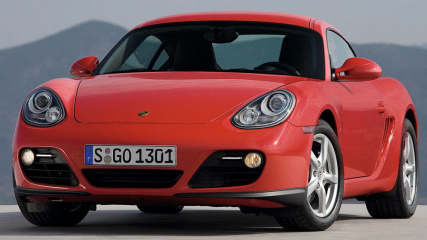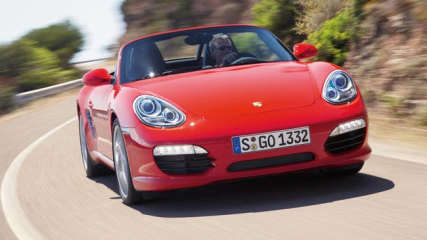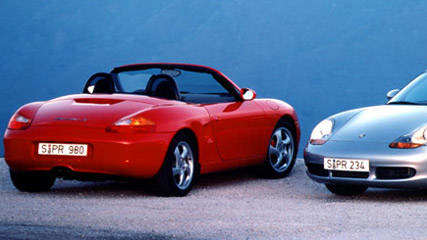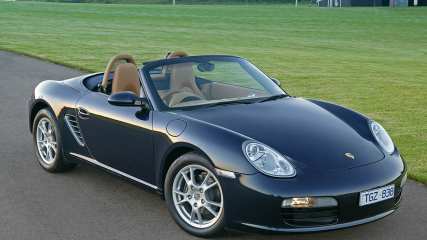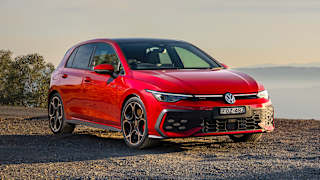Porsche Boxster S 2005 review
By CarsGuide team · 13 Feb 2005
The mid-engined two-seater now clears the 0 to 100km/h sprint in 6.2 seconds with extra kilowatts, extra cabin space and another 20kg on board for a value-added $107,400. The Boxster S is quicker again and starts at $132,500.The result is a more refined, more comfortable Boxster pair with extra style and urge, an inside and out evolution of the 1996 original. It looks better, goes harder and sounds better.This 2005 Boxster sits 9mm longer and 19mm wider with wider track and bigger wheels. The roadster body has more muscle tone, the cabin has more comfort and the Boxster boasts the world's first head airbags for a convertible.The roof can be raised or lowered at speeds up to 50km/h, there's a new six-speed manual gearbox that's standard on the Boxster S and there is no spare wheel.Extra charisma is standard for both Porsches.The Boxster's 2.7-litre boxer engine produces 176kW. The Boxster S develops 206kW for its 3.2 litre, six-cylinder unit.Both produce more power and torque plus deeper bass engine notes than ever.A new induction system divides the airflow into the separate cylinder banks at low speed for more torque and reconfigures for maximum airflow close to 5600rpm.The upgraded Porsche Boxster also has a new exhaust system for fewer emissions and extra wail.These are flexible motors, the S's 3.2 litres with the sharper edge. Both motors love the new six-speed gearbox (optional on the Boxster).While the five-speed Tiptronic, available on both cars and loved by many, is a clever and efficient transmission, the manual offers extra snap, crackle and pop; 3000rpm in fourth sounds adequate, 4000rpm in third offers a sweeter tune, bouncing off the rock walls where this back road is carved through the hills of the Hunter Valley.The kangaroos head for the high ground, the magpies cock their heads as these new songs sweep through the scrub.The Boxsters move on, stirring up dust on the road's edges, sending dead leaves flying.These are cars with attitude and traction, sweet steering and great brakes. There is comfort and surety at high speed, flexibility at low speeds.These are balanced cars, now with 17-inch wheels on the Boxster, 18-inch wheels on the S.Both underfloors are covered for better aerodynamics, higher road speeds and less lift.The brakes are bigger with ventilated discs all round and Porsche's Stability Management system, using brakes to correct under and oversteer, is standard gear.And the steering is now rack and pinion with variable transmission allowing for a little movement at the straight ahead and becoming more and more direct as the wheel is turned. (Among cabin improvements is a height and reach adjustable steering wheel which complements a deeper seating position.)The Boxsters' cabins are better than before with extra room, class and comfort features.Ergonomics and extra gear were among prime considerations in this remake of a car which has become as much part of Porsche heritage as the famed 911s.Ultimately the 911 may be a more extreme, and more rewarding, driver's machine.But this second generation Boxster now has a character hard to ignore and even more ability as a super quick point-to-point sports car.It is one of those machines which makes an ordinary driver look good.On the first run the Boxster S on its new 19-inch wheels feels a touch too hard edged over cracked bitumen, the Boxster has a more gentle, lighter feel on these roads.Push on and on. Now the S and those extra 30kW begin to take hold on the driver out for a decent drive.As quick and agile as the Boxster can be, big brother S offers extra sparkle and smiles.The S is most appreciated with that six-speed gearbox and optional Porsche Active Suspension Management (PASM).This is a very clever package, which debuted on the new 911 Carrera and adapts to road and driving conditions in the blink of a bump.It lowers the car by 10mm and offers the choice between a sporting suspension for long drives or a harder set-up for the club racer.Left alone, the PASM monitors all types of forces on the suspension from braking to cornering, acceleration and bumps. It adds to the confidence and the comfort.So it's a little dab at the brakes, back to second, point the Boxster in and power through, adding a little extra and grabbing third on the exit. There is little trace of tyre noise, the Porsche has high limits of traction for the hardy and the ham-fisted.Now hard through to somewhere over 6000rpm and up to fourth, now slicing through to fifth and sixth.The five-speed manual has been improved but this six-speeder is the one for quick and delicious changes.Chasing down the road the wind ruffles the top of the cap and there is little need for the stereo, there are too many songs to be heard from behind the driver's head.In front are those more pronounced guards, sitting either side of the aluminium bonnet and acting as mobile sights. More directly in front is that large tachometer, a digital reading for speed in the bottom of that analogue gauge. The analogue speedometer sits to the left with other warning lights and gauges.But this is a game mostly played by ear and a game best played on a demanding piece of driver's road. These Boxsters are sports cars for the open road. That the Porsches look good as boulevard cruisers, prettier than ever, is a bonus.PS: Dropping the spare wheel saves 10kg and Porsche supplies a tyre sealant and air compressor for emergencies; Porsche Australia will keep an eye on the issue.
